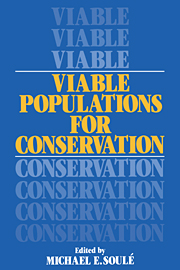Book contents
- Frontmatter
- Contents
- List of contributors
- Preface
- 1 Introduction
- 2 The demography of chance extinction
- 3 Extinction models and mammalian persistence
- 4 Minimum viable population size in the presence of catastrophes
- 5 Minimum viable populations: coping with uncertainty
- 6 Effective population size, genetic variation, and their use in population management
- 7 Spatial structure and population vulnerability
- 8 Managing critically endangered species: the Sumatran rhino as a case study
- 9 The role of interagency cooperation in managing for viable populations
- 10 Where do we go from here?
- Index
6 - Effective population size, genetic variation, and their use in population management
Published online by Cambridge University Press: 21 January 2010
- Frontmatter
- Contents
- List of contributors
- Preface
- 1 Introduction
- 2 The demography of chance extinction
- 3 Extinction models and mammalian persistence
- 4 Minimum viable population size in the presence of catastrophes
- 5 Minimum viable populations: coping with uncertainty
- 6 Effective population size, genetic variation, and their use in population management
- 7 Spatial structure and population vulnerability
- 8 Managing critically endangered species: the Sumatran rhino as a case study
- 9 The role of interagency cooperation in managing for viable populations
- 10 Where do we go from here?
- Index
Summary
A fundamental fact of population genetics is that in closed populations (i.e., without immigration) the presence of only a small number of individuals, sustained over several generations, will lead to the depletion of genetic variation. Thus, the number of individuals is a crucial parameter in determining the amount of genetic variability that can be maintained in a population. This, in turn, influences the probability of long-term survival of a population because genetic variation is requisite for evolutionary adaptation to a changing environment. Thus, maintaining population numbers and genetic variation must be a central theme of plans for long-term population management.
In the last decade there have been several discussions of the role of population genetics in the management and conservation of threatened species (e.g., Soulé and Wilcox, 1980; Frankel and Soulé, 1981; Schonewald-Cox et al., 1983); such references provide a useful background for persons interested in this topic. Here we extend this treatment in four ways. First, we suggest criteria for the management of populations from a genetic perspective. We show how the effective size of a population, the pattern of natural selection, and rates of mutation interact to determine the amount and kinds of genetic variation maintained. Time scales associated with the different processes are also discussed.
- Type
- Chapter
- Information
- Viable Populations for Conservation , pp. 87 - 124Publisher: Cambridge University PressPrint publication year: 1987
- 497
- Cited by



